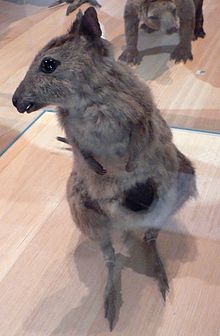The eastern hare-wallaby (Lagorchestes leporides), once also known as the common hare wallaby, is an extinct species of wallaby that was native to southeastern Australia. It was first described by John Gould in 1841.
| Eastern hare-wallaby | |
|---|---|

| |
| Specimen at the Melbourne Museum | |
| Scientific classification | |
| Domain: | Eukaryota |
| Kingdom: | Animalia |
| Phylum: | Chordata |
| Class: | Mammalia |
| Infraclass: | Marsupialia |
| Order: | Diprotodontia |
| Family: | Macropodidae |
| Genus: | Lagorchestes |
| Species: | †L. leporides
|
| Binomial name | |
| †Lagorchestes leporides (Gould, 1841)
| |

| |
| Historic eastern hare-wallaby range in orange | |
Description
editThe eastern hare-wallaby was a small macropod, slightly larger and more slender than its surviving relative the rufous hare-wallaby. It had a body length of about 50 centimeters and a 33 centimeter long tail. Its fur colour varied from black through brown to yellow with a greyish-white belly.[2]
Ecology and behaviour
editVery little is known about this wallaby. It was a strictly nocturnal animal which led a solitary lifestyle.[3] During the day it sat still in a well-formed 'seat', usually in the shelter of a saltbush or a tussock.[4] If approached too closely, it would bound off at great speed. One wallaby was chased by dogs for 500 metres and suddenly doubled back and came back within 6 metres of John Gould and leapt over his head; it could jump 1.8 metres high.[5]
Extinction
editThe last known specimen of this species was a female collected in August 1889 in New South Wales.[5] There were no further sightings of this species, even though researchers well into the 1930s were still uncertain of its extinction.[2]
The cause of its extinction remains uncertain, as it died out before intensive agriculture was introduced throughout its distribution and before the red fox became common in its habitat. Several causes of its extinction have been suggested, including trampling of its grassland habitat by cattle and sheep,[1] changed burning regimes, or predation by introduced cats.[5]
References
edit- ^ a b Burbidge, A.A.; Woinarski, J. (2016). "Lagorchestes leporides". IUCN Red List of Threatened Species. 2016: e.T11163A21954274. doi:10.2305/IUCN.UK.2016-2.RLTS.T11163A21954274.en. Retrieved 20 November 2021.
- ^ a b Francis Harper (1945). Extinct and Vanishing Mammals of the Old World. New York, American Committee for International Wild Life Protection.
- ^ Richard Lydekker (1894). A hand-book to the marsupialia and monotremata (PDF).
- ^ John Gould (1863). The Mammals of Australia.
- ^ a b c Tim Flannery; Peter Schouten (2001). A gap in nature. ISBN 9780871137975.
Further reading
edit- Flannery, Tim; Schouten, Peter (2001). A Gap in Nature: Discovering the World's Extinct Animals. Atlantic Monthly Press, New York. ISBN 978-0-87113-797-5.
- Groves, C. P. (2005). Wilson, D. E.; Reeder, D. M. (eds.). Mammal Species of the World: A Taxonomic and Geographic Reference (3rd ed.). Baltimore: Johns Hopkins University Press. p. 63. ISBN 0-801-88221-4. OCLC 62265494.
